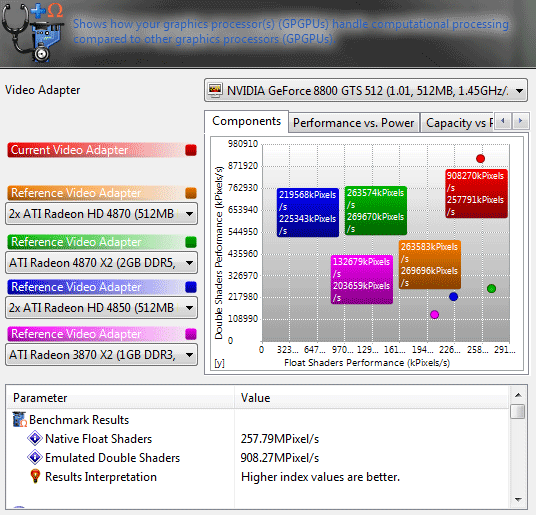[Guru3D] How difficult is it to implement the Video Rendering test and how objective will it remain. Surely AMD, NVIDIA and in the future others, will start optimizing this particular test to gain the best results. Is there a control method e.g. will you monitor driver releases on such optimizations.
[Adrian] The Video rendering test is the equivalent of the CPU & GPGPU computational tests using programmable shaders; this allows users to compare shader performance with CPU and GPGPU performance on the same algorithm. Users without a GPGPU capable GPU can see how their GPUs perform relative to GPGPUs as well as to CPUs.
We have been working with CPU manufacturers on optimising the CPU tests for various instruction sets and technologies so we will now work with (GP)GPU manufacturers as well. As previously, fairness will be ensured: Sandra employs various verification methods, for example digital signing for every executable/library, output results verification, etc.
[Guru3D] A second new addition we noticed is the new Graphics processing benchmark. Quite interesting for sure. Are the video rendering and Compute tests SLI/Crossfire compatible ?
[Adrian] The DirectX (SM4.1, 4.0, 3.0) tests support both Crossfire and SLI. The GPGPU tests are multi-card compatible (up to 8), though current drivers require Crossfire/SLI to be disabled for multi-GPGPU to work.
[Guru3D] The development on computing data on the GPU is a fast growing trend. How important do you think this will graphics processing opposed to graphics rendering be ?
[Adrian] In my opinion, other software, not just video games, will now benefit from powerful GPUs. Thus investing in a GPU will make sense, rather than seem a waste of money if the user is not an avid gamer; if they are then it is one more reason to justify the expense.
[Guru3D] We assume you fire off a hefty set of floating point shaders at the GPU - Can you tell us What exactly is computed in this test ?
[Adrian] The GPGPU benchmarks implement the same algorithm as the CPU benchmarks (released 12 years ago) so the results are comparable, i.e. you can directly compare CPU and GPGPU scores. What is computed is a fractal (Mandelbrot) which is a highly parallelisable algorithm. It was chosen to show the peak performance that can be achieved through various technologies (threading, SIMD, etc.). This algorithm uses little data which allows us to test raw core performance (CPU, ALU, shaders) while still generating worthwhile output.
[Guru3D] For NVIDIA cards to compute over the GPU, you must use CUDA. For AMD ATI cards, you are pretty much tied to CAL. What API is in your opinion better to work with and seems to be the most future proof in terms of 3rd party software development at consumer level ?
Adrian] We use both CAL and CUDA in this release. Though the APIs have different names, they are equivalent in functionality. Both have C/C++ compilers so you dont have to write anything in HLSL or assembler code. With CAL you can write the GPGPU kernel in assembler for better performance - assuming the developer knows what they are doing.
[Guru3D] What is the biggest limitation for CUDA and CAL right now ? What do you think could be changed ?
[Adrian] In my opinion it is the perception that just re-compiling software for GPGPU would be enough to convert an algorithm to run "well" on GPGPU. The architecture of GPUs is quite different from CPUs, thus developers have to re-learn a few things and learn new ways of optimising code to run well. Highly parallelisable benefit most from GPGPUs. Data management is also a lot more complicated as there are different types of memory (local, shared between GPGPUs, system, local on other GPGPUs) of various sizes and speeds.
As a result it may take a while to reap the full benefit of porting to GPGPU.
[Guru3D] With DirectX 11 slowly surfacing on that cyber horizon one fixed function in the pipeline will be Compute Shaders. Do you think CUDA and CAL will become a thing of the past once Microsoft opens up Compute Shaders through their API ?
[Adrian] On the Windows platform, judging by the past, it is highly likely that DirectX 11 will dominate, as supporting a single API is far better than supporting many vendor specific APIs. It is a pity DirectX 11 is not ready now; hopefully it will be out by the time other vendors (Intel, etc.) join the fray.
[Guru3D] What's the next big thing for Sandra development ?
[Adrian] We are always working on many projects; sadly, for the most part, it is a case of wait and see, for the usual commercial and NDA reasons. That being said, we have a relatively quick development cycle and will not keep our users waiting too long. Watch this space...
[Guru3D] Thanks for your time, is there anything you'd like to add / address in this small Q&A ?
[Adrian] May I take this opportunity to ask your readers to contact us should they have any comments/complaints regarding the software; while we may not always be able to get back to each and everyone, all issues are investigated in due time and, if within our power, fixed. Enjoy!
Thank you for your time.
Adrian you too of course thanks for your time.
For more info about SiSoft please visit the SiSoftware website. You can download the freeware version of the all new Sandra 2009 here at Guru3D.com.
- If you like this article please digg it.
- Leave/read comment on this product
- Sign up to receive a notice when we publish a new article
- Or go back to Guru3D's front page

